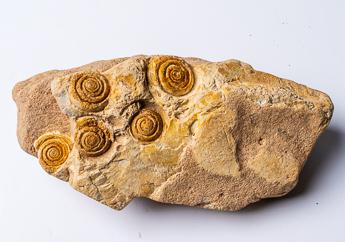Missouri Geological Survey Director: Carey Bridges, RG
Gastropods are a class of mollusk animals that includes snails and slugs. Gastropods came into existence during the earliest part of the Paleozoic Era about 520 million years ago and persist to present day in a variety of forms and lifestyles.

Most gastropods move around by crawling slowly on a fleshy foot that resembles a belly; hence the name gastropod, which was derived from the Greek gastro (stomach) and pod (foot). The foot of some gastropods is adapted for swimming. The original gastropods were marine and had gills for respiration. In late Paleozoic time, gastropods having an air-breathing lung, called pulmonate gastropods, came on the scene and populated land and fresh water environments. Both kinds are still around today.
Snails have a one-piece outer shell that houses and protects soft body parts. Slugs lack a shell. Since hard body parts are far more likely to be preserved than soft body parts, the fossil record of gastropods is almost entirely shells of snails. Slug fossils are virtually nonexistent. Therefore, the number of extinct species probably far exceeds the 15,000 documented to have existed in the geologic past. The number of living species is estimated to be between 40,000 and 100,000.
Shells are made of calcium carbonate in the form of the minerals aragonite or calcite or both. Shells can be uncoiled or coiled. Uncoiled shells are cap-shaped to horn-shaped. Coiled shells wrap around themselves spirally as they grow. Each wrap constitutes a whorl. Planispiral shells are coiled in a plane and exhibit bilateral symmetry. Conispiral shells are coiled helically and lack bilateral symmetry. Planispiral snails became extinct at the end of the Paleozoic Era. Uncoiled and conispiral snails still survive today.
Some marine snails have a horny to calcareous trap door (operculum) with which they can seal themselves tightly inside their shells. It allows them to wait out periods of environmental stress. The gastropod mouth is equipped with a horny apparatus (radula) that is used for scraping and boring. Gastropods eat just about anything. Some scavenge dead plant and animal matter, including fecal matter. Some eat algae and other live plant material. Some are commensal, like the horn-shaped snails that lived attached to the anal sacs of crinoids during the Paleozoic. Some are parasitic. Others are predators capable of boring holes through shells to gain access to tasty innards of the animal inside. Gastropods belong to the Kingdom: Animalia, Phylum: Mollusca (includes gastropods, pelecypods, scaphopods, cephalopods and chitons), and Class: Gastropoda.
Gastropods and other fossils are on display in our Ed Clark Museum of Missouri Geology. They also are found in the limestone walls of the Capitol in Jefferson City.
Nothing in this document may be used to implement any enforcement action or levy any penalty unless promulgated by rule under chapter 536 or authorized by statute.
For more information
Geological Survey Program
Missouri Geological Survey
P.O. Box 250
Rolla, MO 65402-0250
United States
